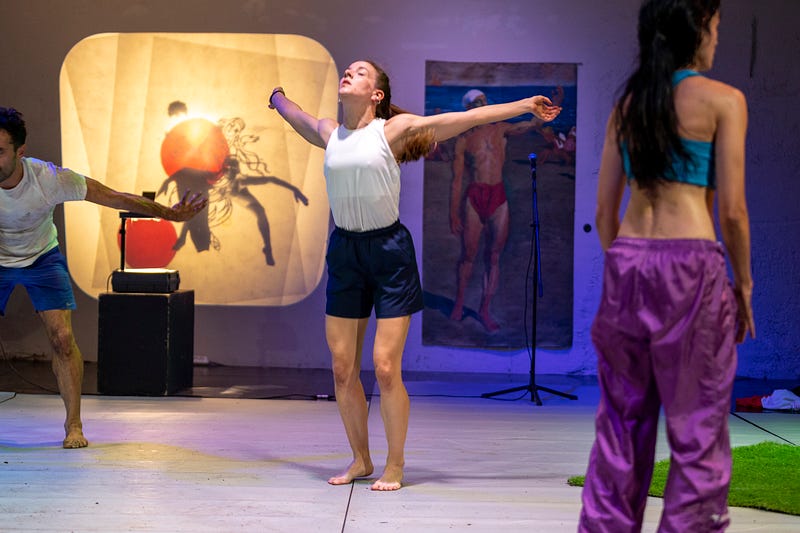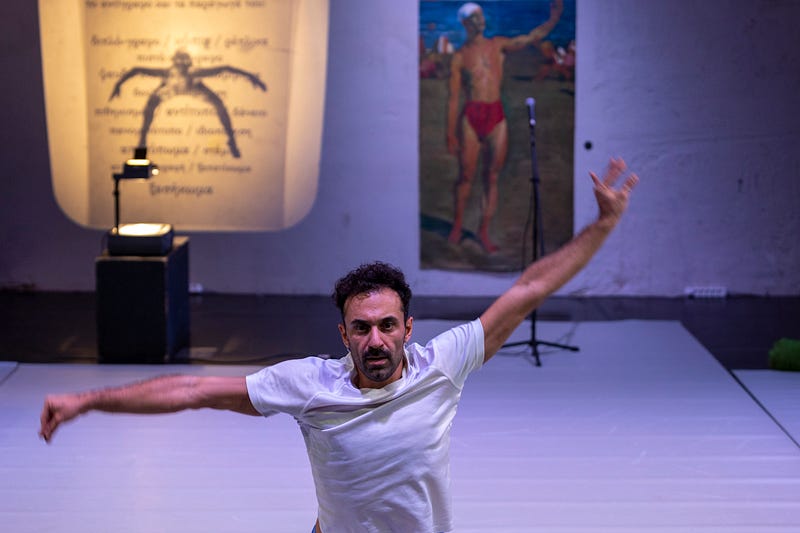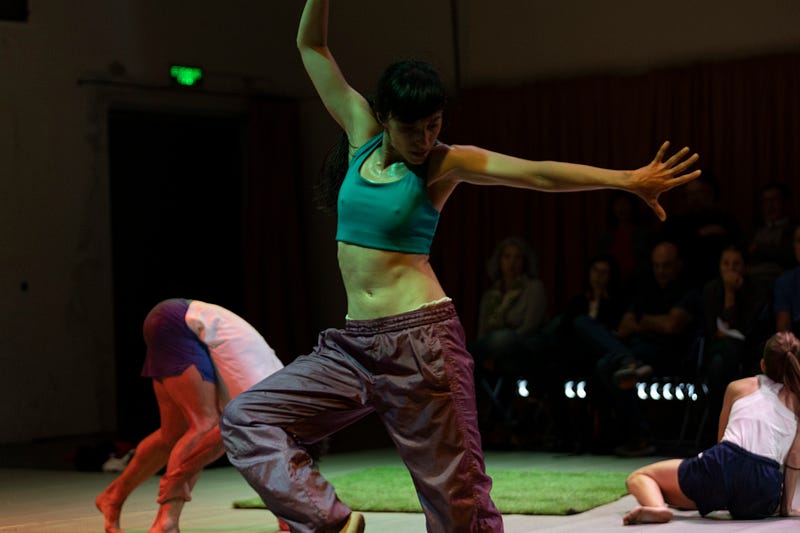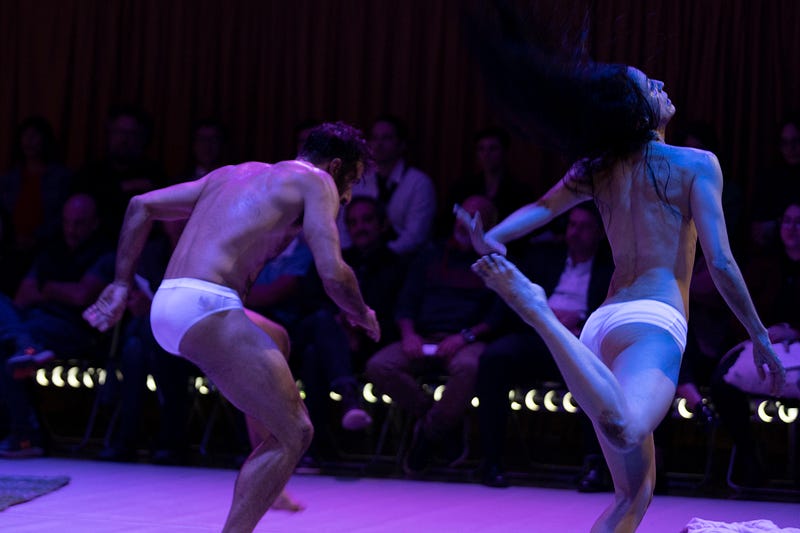29.11.2022
Out of Spring: A messy archive to reconceptualize the multiple narratives surrounding “The Rite of Spring”
Dance
When Aris Papadopoulos and Martha Passakopoulou ―aka the choreographic duo arisandmartha¹ ― suggested taking a “walk” in the wilderness of The Rite of Spring, we knew from the very beginning that this was not going to be another take on Stravinsky’s score. What felt most appealing to us was how dance history is mediated through various mechanisms of representation, it meant thus dealing with the lost original work by Nijinsky as an archive which constantly generates new material; textual, photographic, video, but also imaginary. The process of revisiting the history and historical significance of The Rite of Spring soon became a mnemonic endeavour that would be informed both by the means of mimesis ―what we might blatantly call copying― and that of bastardization. The latter, as we will argue in this short essay, critically re-examines the role of the re-constructor, as someone who stands in-between meaning and action.

History and past are two different things. While past remains open to interpretations, history gains its validity from the accuracy of the attempted interpretations of the past. Accuracy, however, depends on the availability of the sources. As we were “walking” through the vast archival material concerning the original, almost mythical work by Nijinsky or at least what is presumed to be his, it was inevitable that we were going to stumble upon Millicent Hodson’s 1987 reconstruction for the Joffrey Ballet. Joan Acocella, the famous dance critic of The New Yorker magazine, wrote an article questioning Hodson’s methods of choreographic reconstruction given the little but many pieces of evidence she had.² To summarize it in her exact words: “how can dance be derived from non-dance evidence?” Although at first glance it is tempting to say the former was wrong and the latter was right, such easy dichotomization would mean negating the very performative aspect of the archive: the quest for the “Lost Nijinsky”, we believe, referred to the mythical aura surrounding the artistic genius of Nijinsky but also the riotous (missing) birth act of modernism in dance. Therefore, it felt more fascinating to ‘stay with the trouble’ by trying to incorporate this very contradiction between representation and authenticity, historical fact and reproducibility.

André Lepecki in his essay “As If Dance Was Visible” notes: “dance is profoundly informed, constituted, built upon mo(ve)ments that exceed the economy of the ‘purely physical’” thus suggests the understanding of choreography “as an activity that surpasses the boundaries of the visual.”³ Lepecki takes new liberties on the mediating role of the writer as preserver⁴ of the dance event and somehow conflicts the above rhetoric by Acocella about the scarcity of the available evidence and the educated guesswork Hodson did to fill in the missing gaps in the reconstruction of Nijinsky’s choreography. Lepecki sees the act of remembering as an endeavour to revisit “dance’s mnemonic space” ― “a space not belonging to the realm of representation, but that allows representation.”⁵ Such statement defies the old scholarly approach that reconstruction could be all about the unchanging nature of the work ―Hodson’s one has already become ‘historical’― based on as many evidence as possible. It actually questions how the very eventfulness of dance could be preserved and reproduced, leading maybe to what Mark Franko calls a “reinventive” approach in dance reconstruction: “Reinvention sacrifices the reproduction of a work to the replication of its most powerful intended effects.”⁶

It’s no coincidence that two concepts appear here; sacrifice and replica. In Out of Spring we had replicas of Sacrificial Dances from various choreographers suggested by the Oxford Dictionary of Dance, ready-mades we were able to find on YouTube. YouTube is an open-source streaming channel, so we used it as an unauthorised instructor to get access to the choreographies we wanted to learn. Dancers are skilled to learn by watching videos and practicing ―this is a method actually that depends too much on the visual aspect of the choreography, but it was interesting to see how the flattened image on the screen was somehow enlivened in the dancers’ bodies, or to paraphrase Peggy Phelan, how dance was making an appearance during the learning process. To counter balance the lack of evidence while reinventing and juxtaposing those fragments, we used speech, a sort of caption that would allow the audience to get the whole picture. But “whole” is just a way of saying, since accuracy was not a set goal. Instead, we went for what Franko defines as “making a theatrical experience out of the realization of what [we] had eliminated” in order to theatricalize the very process of (a failed) reconstruction. The missing part, resurfaced in the form of text or historical evidence, bits of information we shared with the audience in the loose format of an improvised lecture.

In the purest sense, what was left for us to discover was our own version of Sacrificial Dance. To go back to Franko’s words, we looked for those “most powerful intended effects” so that both dance and music would not be just traces of a rehearsed past, but negotiating moments towards a future. We knew where dance was coming from ―as a source, inspiration and embodied knowledge― but we didn’t know where it was going. We have entered this mnemonic space of The Rite of Spring chasing ghosts, trembling figures of the past, also maybe wanting to grasp the inevitable; a sacrifice, an exhaustion, a climax that stays with you for over a century, a myth that keeps repeating itself, reinventing itself, feeding futurity.
Anastasio Koukoutas is working in the field of dance theory, dramaturgy and writing. He studied (BA) Communication and Marketing at the Athens University of Economics, (MA) Performing Arts Administration at Accademia Teatro alla Scala (in collaboration with Bocconi University), Ethnomusicology at the National and Kapodistrian University of Athens (within the e-learning course Greek Music Culture and Education). He has worked, in the publishing field, as a contributor and editor, for art institutions and organizations, such as: Athens & Epidaurus Festival, Stegi Onassis, Dimitria Thessaloniki Festival, Megaron — The Athens Concert Hall et.al. He has worked as a dramaturg in theatre and dance performances (Athens Festival, Stegi Onassis, Experimental Stage of National Theatre in Greece, Arc for Dance Festival, Porta Theatre — Athens et.al.). He writes frequently about dance for the websites springbackmagazine.com, artivist.gr, und-athens.com, and teaches Dance History at the dance college ΑΚΤΙΝΑ. Last but not least, he has worked as a performer for Denis Savary (Lagune –National Museum of Contemporary Art, Athens — 2016), Virgilio Sieni (Biennale Danza / La Biennale di Venezia — 2016), Pierre Bal Blanc (documenta14–2017), Dora Garcia (Megaron, The Athens Concert Hall — 2018) et. al.
arisandmartha is the creative collaboration between dancers, performers and markers Aris Papadopoulos and Martha Pasakopoulou. Based in Athens they work in the crossroads of dance, performance and site-specific exploring togetherness on and off stage and experimenting with movement and performative languages under a variety of conceptual ideas. Aris Papadopoulos and Martha Pasakopoulou are both SNF ARTWORKS Dance Fellows.
[1] Here, the terms choreographic and duo are used on purpose; first to signify the amplified field of choreography beyond dance, secondly, because duo in this case refers to a multiplicity that may exceed the stereotypical gendered role of two partners. As it is often the case with arisandmartha the duo might be also imply a multiplicity that involves actively in the making more than the choreographers; the dramaturg (Anastasio Koukoutas), the musician (Jeph Vanger), the light designer (Eliza Alexandropoulou), but also an extra performer (Christina Karagianni).
[2] Acocella, Joan, The Lost Nijinsky, The New Yorker, May 7, 2001 issue
[3] Lepecki, André, As If Dance Was Visible, Performance Research 1(3), pp. 71–76, Routledge 1996
[4] Lepecki, André, ibid.
[5] Franko, Mark, Repeatability, Reconstruction and Beyond, Theatre Journal, Vol. 41, №1 (Mar. 1989), pp. 56–74



